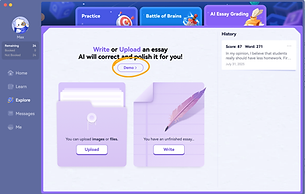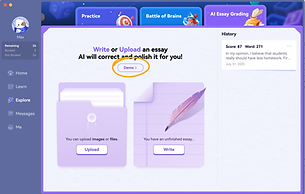AI Essay Grading
You won't see this feature in your teacher app, but we want you to be familiar with it in case students bring it up. You may also suggest students try this feature out - they may not have fully explored their app, and you can bring it to their attention! We're going to talk about the AI essay grading feature.



Students will see a menu on the left side of their homepage. If they click explore, they'll see three options: practice, battle of brains, and AI essay grading. You can check out the other training videos on the practice feature and the battle of brains!

By clicking "demo," then "try demo," students can see an example of how the AI essay grading works.
And when they're ready to try on their own, students have the option to upload an image or file of an essay they've already written, or they can write their essay within the app. If they choose to write the essay, they can type directly into the app. They can also copy and paste in text from another document - like if they've already written in a Google Doc.



In this video, we've pasted in an example essay from a 6th grader to test it out. Once we hit submit, we'll get Cosmo's AI insights.

This student has a good start, but they've got some room for improvement - as well as some grammar mistakes to fix.
The evaluation looks at four domains: focus and organization, evidence and elaboration, voice and word choice, and grammar and conventions.
The student will see a short summary of their writing piece, plus a score and some feedback for each domain. Scores are out of 100, with each domain worth 25 points. Keep in mind that this score is AI-generated, so it's not perfect, but it gives students an idea of their strengths and areas for improvement.


Moving on to suggestions, these are organized sentence-by-sentence.
Some are classified as a "polish," which means the AI has a suggested improvement, but the original phrasing might not be incorrect. For example, it suggests that we remove "In my opinion" from the very first sentence because it's redundant. Just stating "I believe that students should have less homework" is sufficient.
Others are indicated as corrections. Corrections indicate errors in grammar, punctuation, spelling, and capitalization. For example, the correction in sentence two indicates a missing comma. It's a compound sentence, so a comma is required before the conjunction "but" to join the independent clauses.

And finally, students can take a look at the revision tab. Here, the AI has applied all the suggestions from the second tab, so students can see a polished final product - and they can compare it to their first draft on the left.

Notice that once we've submitted a piece for scoring, it shows up on the right-hand side as part of the student's history, so their work isn't lost.